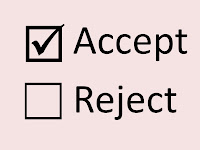In the previous posts, I've covered a lot of ways to improve writing productivity and to avoid writing problems. Some of the suggested strategies are useful to get people started writing regularly (e.g.,
contingency management), to write unselfconsciously (e.g.,
spontaneous writing), and to deal with specific problems (e.g., perfectionism, procrastination). Eventually, however, writers must develop a strategy for the long-term.
The long-term strategy will incorporate some of the short-term techniques, such as writing when fresh (early morning) or having a conducive writing space. But what are the most important factors determining whether a writer becomes highly productive? Based on my own experience and discussions with colleagues, the most successful, highly productive writers have three characteristics:
1. They make writing
the priority in their daily work schedule.
2. They enjoy writing.
3. They continually work to improve their writing.
I certainly did not start out with these characteristics--far from it. Initially, I put other things before writing, which was delayed until I had a block of time to write. I found writing to be a chore, a struggle, and definitely not my idea of fun.
Writing is easy to put off when it's not a priority and is not enjoyable. We have labwork, fieldwork, meetings, administrative tasks and email that demand our immediate attention. We finish a research project and think, "Well, I guess I'd better start thinking about writing something up." There follows a long period of dithering around, staring at the data, hoping that the words will magically jump from our brains onto the page, and when that does not happen we begin wishing that we could just go on collecting more data and not have to worry about authoring a brilliant exposition. Time passes and no real writing progress occurs. Or if it does, the result is pedestrian, unimaginative, and disjointed.
Sound familiar?
If you've been reading the previous posts, you'll know that writing should be done on a regular, daily basis. Binge writing, particularly starting from scratch is the least efficient way of proceeding. Better to write in small increments and to start writing early--not at the end of the study. By developing the habit of daily writing--even for short periods, a scientist can become much more productive than one who only writes in jags.
As I progressed through my career, I went from avoiding writing to writing in binges--essentially waiting until I had all data in hand to begin writing. It was easy to procrastinate because there was always something else that needed my attention. Now, however, I put writing tasks at the top of my list. What this means is that every day I'm in the office, my goal is to write. Everything else is an interruption to the writing. If I have to stop and go over something with a staff member or deal with an administrative issue, it is only an interlude in the writing. As soon as I finish the other task, I go back immediately to the writing. Writing is my default position.
Of course, some days I only manage 30 minutes or an hour of writing. I always have several writing projects underway, and I try to keep them all moving forward. When I only have brief snatches of time, I try to get a few paragraphs or a page done on the newer writing projects. Days that I have longer blocks of time are devoted to the papers that are closer to completion. Once I have a rough draft of all main segments (Introduction through Discussion), I focus completely on that paper until it's finished and submitted. If a paper is accepted, I drop everything to do the revision (a bird in the hand...). That is what I did today--revised an accepted manuscript with minor revision.
The second factor--to enjoy, even love writing--is a bit more difficult to accomplish. For most people, this comes with time and experience, but only if writing problems are consciously avoided. I tend to think about writing experts as being similar to skillful musicians or dancers. The people who are at the top of their field are so good that they make it look easy. But the key to loving what you do--playing music, dancing, or writing--is to reach that stage where you can relax and have fun with it. Some estimates suggest that to become an expert at something, you have to spend about 20,000 hours practicing. That's about ten years--the same amount of time one spends in graduate and post-doctoral work. So if one focuses on writing skills early, beginning in graduate school (or earlier), it's possible to be an expert by the time that first job comes along.
The third factor is that excellent writers constantly work to improve their skills. They never rest on their laurels and think, "Now that I'm an expert, I have nothing else to learn." I read about writing, study other writers' work, try new writing approaches, and think a lot about writing. This may be too much of a good thing for some people, but people who love to write pay a lot of attention to improvement. And this effort pays off.
In coming posts, I'll try to talk about some specific techniques to improve technical (science) writing.
 4. This movie was released in 1982.
4. This movie was released in 1982. 




















